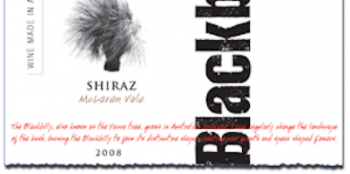My first real introduction to dry red wines was by way of Australia. The bold red wines produced there match the personality of its people: lively and exciting, with an explosion of flavor. Australian wines (and its people) are rarely subtle or boring.
Shiraz is the grape that really put Australian wine on the map, but it’s actually the same grape as Syrah, which is widely planted in France. The Syrah grape is the fourth-most-planted in France, with a large percentage grown in the Rhône valley, but like with most wines from that country, Syrah is often mixed with other varietals to make custom French blends.
In Australia, however, there are plenty of single varietal Shiraz bottlings. I use the term “single varietal” with some qualification: different countries have different rules about what can be put on the label. In Australia, up to 15 percent of the wine can be from a different grape while still being called a single varietal. (For example, a bottle labeled Shiraz might have up to 15 percent Cabernet Sauvignon blended in.)
Australian wine did not register on the radar of most drinkers in the United States until the 1990s, when imports rose dramatically (from 578,000 cases in 1990, to 20 million cases in 2004). The Shiraz/Syrah wines from Australia were and still can be big, tannic, jammy, full-flavored “fruit bombs” with a peppery finish.
If you’re like me and appreciate the tannins (which create that puckering, cotton-mouth sensation), Aussie Shiraz makes for an easy introduction to dry red wines, because of the overwhelming fruit flavor characteristics. (If you don’t like the tannins, try Merlot or Pinot Noir instead.) In my experience, wines from McLaren Vale and the Barossa Valley tend to fall in this “fruit bomb” category: rich, intense, with higher alcohol and flavor profiles in the “dark fruit” category, like black cherries and blackberries.
If the fruit bomb style is too over-the-top for you, not all Aussie Shiraz is that way. In cooler climate regions, like the Yarra Valley, Eden Valley, and Coonawarra, Shiraz is definitely more low-key, with “red fruit” characteristics, lower alcohol, and higher acidity. Check the region on the label before you make a quick purchase.
The “fruit bomb” style has predominated in Australian Shiraz, but the pendulum is swinging toward a blend of fruity and savory flavors with a little bit of restraint. But don’t worry — it’s still Australian wine, and “restraint” is a relative term.
Penfolds Grange is the premier Shiraz of Australia, ranking at the top of the wine world alongside Grand Cru Bordeaux blends. But it’ll set you back quite a bit — say, hundreds of dollars per bottle. I recently saw the 2008 selling for $850. Yikes!
Fortunately, Australian wine is flooding the market right now. In the early 2000s, when demand for Australian wine was huge, wineries planted more and more vines and increased production. Now that demand has plateaued, and even decreased on occasion, there’s more wine sitting around than there is demand for it. (Some have even called for wineries to rip vines out of the ground to lower future supply.) As a result, you can probably find some great Shiraz that won’t break the bank.
If you’re trying Aussie Shiraz for the first time, don’t bother with Yellow Tail; it’s not even sold in Australia, and Aussies themselves laugh about Yellow Tail the same way they do about Foster’s Beer. Instead, check out Jacob’s Creek or Rosemount Estate for inexpensive introductions.
For a bit more cash, around $18 to $20, the 2008 Blackbilly Shiraz is great: a dark garnet, almost purple, color with crushed dark fruit on the nose, intense dark berries on the palate, hints of coffee, chocolate, and a little bit of a savory, gamey flavor. The 2010 Gatekeeper Shiraz is nice as well, showing raspberry, licorice, and chocolate on the nose, with flavors of cherries, plum, and black pepper on the palate, for a cool $14.
There is some debate as to the value of of aging Australian wines. Many ask if the flavors will hold up after 15 or 20 years. In the past, most people said they would not. But in recent years, some experts have begun to change their minds.
In my own experience, the best Australian Shiraz I’ve ever had was The Gate from the excellent 2002 vintage. This was by no means a top-dollar bottle, but after 11 years in my cellar, my wife and I drank it for our fifth wedding anniversary and it performed beautifully: dark berries, licorice, dusty and aged on the nose. A mix of blueberries and blackberries, vanilla, savory herbs, leather, crushed black cherries, molasses, and licorice on the palate. The finish was gloriously long. Not overly complex, but the time spent in the cellar brought out some great flavors.
Aged or not, Shiraz is a spectacular introduction to dry red wines, and the Australian single varieties are often a delicious choice.
